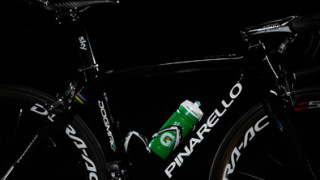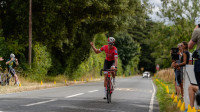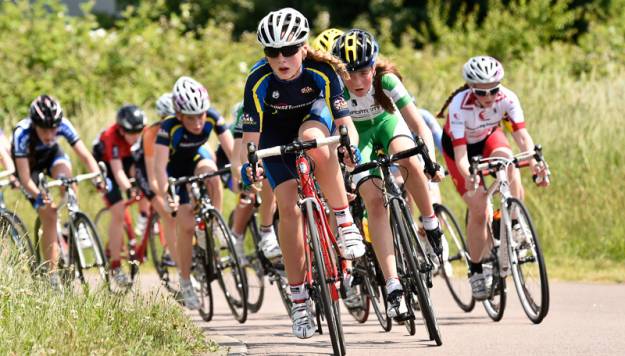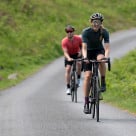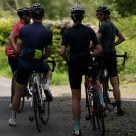|
“I’m obsessive compulsive,” Mark Cavendish told Cycle Sport's Edward Pickering in a 2010 interview. Someone less blunt about his own personality might say he was extremely meticulous, and Cavendish is well-known as a perfectionist. It's his attention to detail – as well as his famous determination - that's helped make him the best sprinter of his era and propelled him to victory in the 2011 world championships.
According to Team Sky mechanic Gary Blem, one of the things Cavendish is particularly meticulous about is the set-up of his bike. Many riders tinker with their position in the early season then leave it alone, but Cavendish constantly makes changes to tailor his position to the day's racing.
Originally from South Africa, Blem has worked with Cavendish since 2010, and joined Team Sky at the beginning of 2012. He's developed a deep familiarity with the Cavendish way of doing things. “He knows what he wants and I have learnt to give him exactly what he wants,” says Blem, acknowledging that Cavendish's experience makes him the unequalled expert on what works best for him.
Cavendish is riding a Pinarello Dogma 2 with a special geometry catering for his body shape. In a sloping top tube configuration, it's a nominal 50cm frame with an actual seat tube length of 46cm and a 50cm head tube.
How low can you go?
The main objective of Cavendish's position on the bike is to get him low for the sprints.
“He tries to go as low as possible in the front and if you look at him in the sprints, he's very, very low,” says Blem. “We've got him as low as we can get him.” That low position is mostly achieved through the bike's short head tube and flat stem. The handlebar is a standard-drop anatomic shape, made by PRO, the arm of Shimano that deals with components other than gears and brakes.
We're talking after stage three of Tirreno-Adriatico. It's been a good race for Team Sky so far, with Cavendish winning stage two and Edvald Boasson Hagen taking that day's stage.
Nevertheless, Cavendish is asking for changes to his bike position. He “changes his position on a regular basis,” says Blem. “I'd say maybe two or three times per week. Since yesterday he's gone from a 130mm stem to a 120mm and we've just added extra hoods on his bike because he wanted a beefier feel to the handlebars.”
These aren't small changes, “but the thing is, he knows what he wants,” says Blem. “He'll change his saddle up to one and a half centimetres up or down before a 200km stage without a problem. Some riders will feel one millimetre, he can change it by one and a half centimetres.”
And Blem has worked with Mark Cavendish for long enough to understand the rationale behind the constant adjustments. “His thinking is that his body is changing on a regular basis. You know that you're taller in the morning than you are in the evening, that's his theory, his body changes, he becomes more supple, or he gets fitter. He sees his body as being different every day so he wants to change his bike.”
Cavendish also tailors his position to the ride ahead. In the mountains, when he's not going for the win, he adopts a more upright riding position compared to the deep tuck he uses when he's going hell-for-leather for the line.
“In the mountains he'll ride his handlebars one centimetre higher than in the flat stages or the sprint or flat stages,” says Blem. “He likes to ride with his hoods raised, more like a chopper style. He's got the [Shimano] Sprint Shifters on the handlebars for quick shifting.”
Bike wheels and stem: vital stiffness
Most of Cavendish's other choices are about bike stiffness in the sprints and comfort for the ride to that point. His Pinarello Dogma 2 frame though, hasn't had any special attention to stiffen it up.
It's Cavendish's first season on the Dogma 2, and Blem says, “he's adapted really well to the Pinarello and he's really happy with it. The bike was stiff already,” so Pinarello didn't have to do anything with the carbon lay-up to stiffen it for Cavendish. “Remember it's very compact,” which helps keep it stiff, says Blem.
One major area of attention is Cavendish's wheels. “He's very particular about his wheels,” says Blem. “Because of his pedalling style he really flexes the bike in the sprint and likes his wheels exceptionally stiff.
“Then he's got his beefy stem that PRO have developed for him, and I see that some other guys in other teams are using that as well.”
Comfort touches for long days
Cavendish doesn't go for for the stiffest possible saddle though. “He rides a carbon fi'zi:k Arione CX Braided saddle. It's not a full carbon saddle, the full carbon he finds is just to hard for him, so this one has a plastic hull and carbon rails.” And while Cavendish likes to try lots of different options, he's sticking with the Arione because it fits him.
His handlebars are similarly set up for comfort. “He's very particular about where he wants the padding to go on the handlebars. He likes extra gel padding under the hoods and he's actually got two layers of gel on the handlebars currently,” says Blem, laughing as he adds: “but that might change!”
In fact that's almost a certainty. Cavendish adjusts his position right through the season. “It's a continuous process,” says Blem. “He won yesterday, and he already changed his position last night. He will win, and you think 'He won't change it now, that's the winning position.' But not to him, he'll change it and he'll change it quite drastically.”
Cavendish is far from the first rider to be obsessed with his position on the bike. He'd almost certainly brush off the comparison, but the great Belgian rider Eddy Merckx was renowned for constantly tweaking his bike set-up.
Merckx was desperate to find a comfortable position after a crash twisted his pelvis, but Cavendish has no such problem. Perhaps he's looking for a psychological edge as well as a physiological one.
“That's pretty true,” says Blem. “He's had a few incidents with mechanics where the guy will say 'raise your saddle 3mm or 5mm at a time, don't raise it one and a half centimetres in one go' and I think he gets irritated with that.
He's the one who has to ride the bike for 200km and he's been a pro long enough!
“If he were just starting out I would advise him and say 'it's not so wise to do that' but because he's been racing for so long, he knows his body. He knows that it's supposed to be a bit of a stupid move to drop your saddle one and a half centimetres before a 200km stage but he seems to work through that and still get the victories.”

